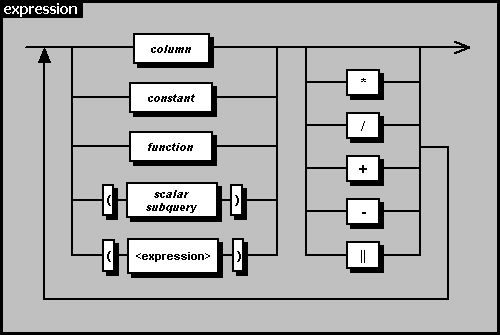These can be used anywhere SAND CDBMS SQL syntax calls for a value
expression, for example, in the projection list of a SELECT
statement, as new column values in INSERT or
UPDATE statements, and in the query expression
of a CREATE VIEW statement. A value expression
is an argument that evaluates to a single numeric, character string, or date/time
value (the data type of the expression must be appropriate to the statement
in which it is used). Value expression primaries, which are
the "building blocks" of the value expression argument, consist
of direct column references, character or numeric constants, functions, the
arithmetic operators +, –, *, /, and the
string concatenation operator ||. A value expression may also contain
another value expression enclosed in parentheses.
The value expression argument is described in the following syntax diagram:

column
The column argument specifies the name of a column belonging to a table
or view. If the column name is not unique across all the tables used in the
query expression, it must be qualified with a table name or alias (correlation
name). Only numeric values may be part of an arithmetic operation; only character
values can be used with the concatenation operator.
constant
The constant argument specifies a character or numeric literal. A numeric
value may be preceded by a unary operator (that is, a
+ or –) to indicate whether it is a positive or negative
value. A character string must be surrounded by single quotes. Only numeric
values may be part of an arithmetic operation; only character values can be
used with the concatenation operator. Refer to the Literals
(Constants) section for more information about constant values.
function
A function can be applied to all input values, resulting in a single output
value. (See the next section for more details about functions.)
( scalar subquery )
The ( scalar subquery ) argument must return a single value only. If
more than one value is returned, an error condition is generated. If the subquery
result set is empty, a null value is returned instead. Note that the entire
SELECT statement must be contained in parentheses.